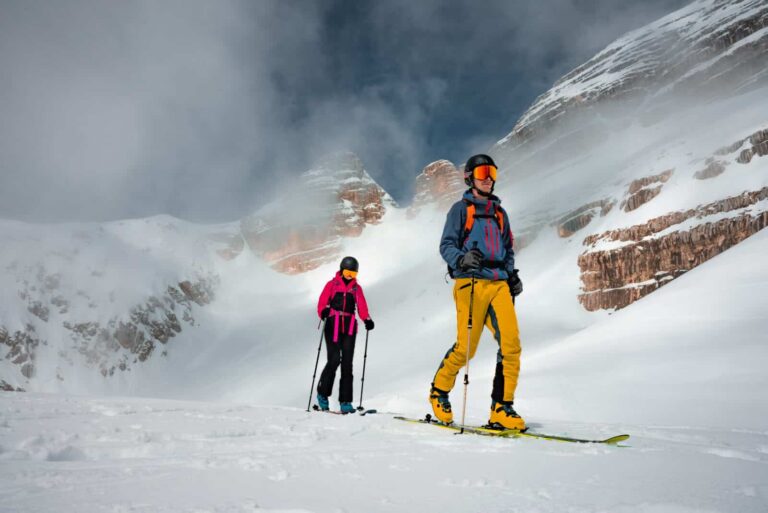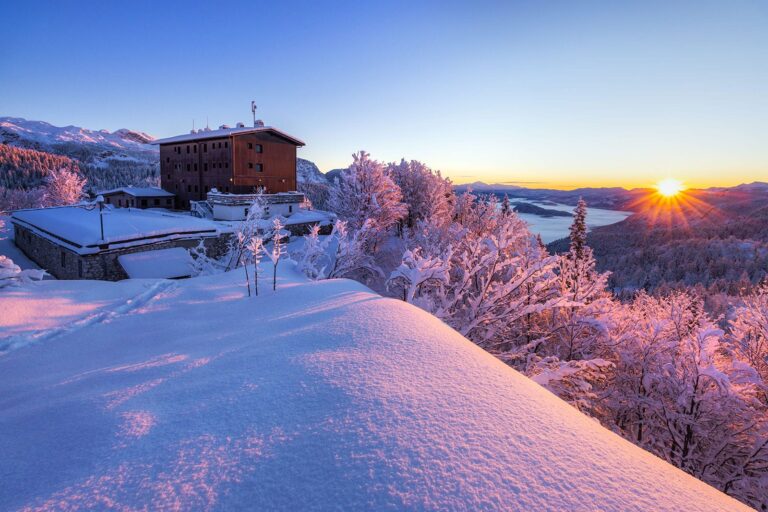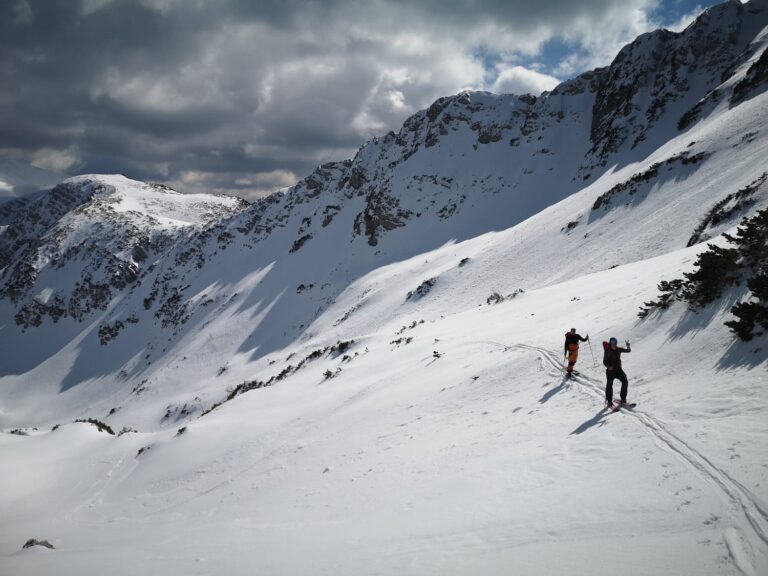Ski Touring: Hike Up to Ski Down!
By DBP Adventures
30 December 2024
Updated 1
There’s a reason why many say Ski Touring is both the best and most challenging thing you’ll do – it’s all about earning your turns while creating unforgettable memories.
Ski Touring, also known as randonnée, combines the techniques of cross-country skiing with downhill skiing. Here, you hike up the mountain using climbing skins on your skis and then ski back down. The reward? Access to untouched terrain far beyond the reach of ski lifts, where you’ll carve fresh lines in pristine powder with hardly another shier in sight.
Curious to learn more about this unique way of skiing? Read on as we dive into the most asked questions, address common concerns and share our top tips to help you make the most of your Ski Touring experience.

Ski Touring is more than just a skiing experience – it’s a unique blend of fitness, adventure and the opportunity to truly explore nature’s most remote and untouched corners. Those who try this form of skiing quickly understand why it’s celebrated as both challenging and incredibly rewarding.
The combination of hiking up through stunning landscapes and skiing down untouched slopes provides an unmatched sense of accomplishment. Each trip offers not only breathtaking views and exhilarating runs but also a deeper connection to the natural environment. Ski Touring isn’t just about reaching the summit – it’s about the journey, the effort and the memories you create along the way.
Benefits of Ski Touring
- Physical Challenge
Climbing mountains on skis engages your entire body – from legs and arms to your core and lungs. This physical exertion not only builds strength and endurance but also allows you to enjoy the breathtaking natural surroundings as you ascend.
- Incredible Reward
We all know the feeling – that unmatched thrill of being the first one to carve lines into fresh powder. Combined with the quiet serenity around you, Ski Touring offers an experience that’s difficult to compare to skiing in crowded resort systems.
- Complete Presence
As you hike up the mountain, you truly have time to soak in your surroundings. The silence allows you to hear the subtle sounds of your skis gliding, feeling the warmth of the sun on your face and watch as the landscape transforms the higher you climb.


Planning and preparing
Embarking on a Ski Touring adventure requires thorough preparation and careful planning. Here are a few key considerations to keep in mind:
Choosing the Right Destination
Select a location that matches your experience level and goals. If you’re a beginner, it’s a good idea to start with simpler routes that feature clearly marked trails. More experienced skiers can explore more advanced peaks and remote areas.
We highly recommend Slovenia’s Julian Alps, the unique landscapes of North Macedonia, and of course Chomonix with Europe’s highest mountain – Mont Blanc.
Equipment and Packing Essentials
Beyond the standard ski gear, it’s crucial to have the right tools for uphill trekking. Make sure to also pack clothing suitable for changing weather conditions, along with food and water to keep your energy levels high.
Let’s take a closer look at packing essentials.
- Skis and Bindings: Ski Touring skis are designed to be lighter and are shaped differently than traditional piste skis, making uphill trekking easier. The bindings are also specially designed, allowing for a free heel during ascents and locked heel for stable descents.
- Climbing Skins: These essential tools attach to the base of your skis, providing grip as you hike uphill. They are one of the most crucial components of your setup and ensure you can efficiently tackle steep climbs.
- Safety Equipment: At a minimum, you should carry an avalanche transceiver, shovel and probe. For added safety, investing in an avalanche airbag backpack can be a wise choice.
- Layered Clothing: Following the principle of layering ensures that you can adjust your clothing based on changing weather conditions – a necessity in the mountains where we all know that weather shifts can happen quickly.
Safety and Avalanche Awareness
Avalanche safety is absolutely essential when it comes to Ski Touring. It’s critical to understand how to identify risk zones and ensure you’re using proper safety equipment such as an avalanche transceiver, shovel and probe. These tools, combined with the right knowledge, can make all the difference in navigating potential hazards.
Tip! If you’re unsure where to begin or want to experience Ski Touring with others who share your passion, consider joining a guided Ski Touring trip. At DBP Adventures, we organize these types of tours for people seeking an adventure. With us, you can embark on dedicated Ski Touring trips to destinations like Slovenia, France and North Macedonia. These adventures often include a mix of Ski Touring and off-piste experiences – offering best of both worlds.


Common Mistakes (and How to Avoid Them)
When you’re new to Ski Touring, it’s easy to make a few missteps. Fortunately, many of these can be avoided with proper preparation. Here are some of the most common errors and tips for steering clear of them:
Poor Planning: Always check the weather and avalanche forecasts before heading out, even if you think you know the area well.
Wrong Equipment: Ensure that your gear is suitable for the terrain you’ll be navigating.
Overestimating Your Abilities: Start with easier routes to build confidence and skills before tackling more challenging terrain.


Our Best Tips for Improving Technique
Like all forms of skiing, Ski Touring is dependent on technique. The better your technique is, the more you’ll enjoy your time in the mountains – both on the ascent and descent. Whether you’re a beginner or have years of experience, there’s always room for improvement. Technique is one of the keys to conserving energy and maximizing your performance during a day in the mountains.
When ascending with climbing skins, finding a steady rhythm is crucial. Moving efficiently without tiring yourself out too quickly isn’t just about strengths – it’s also about managing your body’s energy wisely. For example, using your poles effectively to push off in sync with your steps helps offload effort from your legs and engages your upper body.
A common mistake is focusing too much on climbing quickly instead of prioritizing a consistent pace that patches your fitness level. The same principle applies to the descent: maintain a pace that allows you to feel confident and in control. This approach lets you enjoy the experience and scenery, even when the challenges mount.
Descending in Ski Touring requires a different approach compared to skiing on groomed slopes. Most of the time, you’ll be navigating deep snow and variable terrain, so it’s essential to center your weight over the skis and maintain a flexible stance. This position allows you to adapt easily to the changing conditions beneath you.


“I traveled with DBP to North Macedonia to try Ski Touring for the first time. It was an absolutely amazing trip, with new and exciting adventures every day! Ski Touring is the perfect combination of two activities I love – hiking and off-piste skiing – and North Macedonia, together with DBP, is a fantastic place to start if you’ve never tried it before.
The absolute highlight of the trip was days three and four. On day three, we began with a summit tour to the highest point of the mountain range, Titov Vrv, at 2,748 meters. Afterward, we enjoyed a long descent to a shepherd’s hut, where we stayed overnight until the next morning. Day four featured a five-kilometer tour along a mountain ridge, where we had lunch on the border between Kosovo and North Macedonia – an unforgettable experience!
The trip was an incredible mix of skiing, hiking, nature, culture, history, and so much fun with the other guests. You really bond with the group – I’m definitely coming back next year! See you there!”
– Emil
Ready for a Ski Touring adventure? Check out DBP Adventures’ trips here, where we have something for everyone – no matter your previous experience!